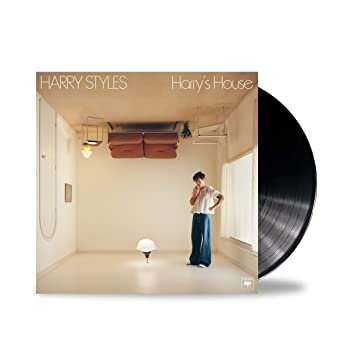Styles’ Harry’s House is a Grower, Not a Show-er.
I have to say, when I was asked if I wanted to write a review of Harry Styles' latest album Harry’s House, I was pumped. This article, however, took me far longer than I expected it to because once I started writing, I realized I have too many layered thoughts about the collection as well as an immense amount of emotional investment in Harry’s evolution as an artist. I don’t think I’m alone in this; Harry Styles belongs to everyone. So, as I sit on my couch finishing up this piece at 11 p.m. on a Monday, I have finally sorted my thoughts. Without further ado, here are my takeaways from my time spent in Harry’s House.
On Harry’s House, Styles wants to be the grooviest, bounciest version of David Bowie or Prince.
This album channels Bowie’s “Let’s Dance” crossed with Prince’s “Kiss” and “Let’s Go Crazy,” complete with crackles, screams and static that emulate these staples of 70s/80s culture. It’s easy to see how Harry could gravitate toward his iconic androgynous predecessors (is Elton next?). He wants to dance in a different decade, shifting his sound to be a bit less raw, leaning more atmospheric and electronic.
Like many artists feel they need to do from album to album, Harry was feeling the need to shake up his sound on Harry’s House.
I don’t know how I feel about this desire to change, but I can honestly say I’m not surprised. On the one hand, growth and diversifying is good, but it has me wondering if Harry is changing to fit what he wants, or if he’s changing for the sake of changing? This album-to-album shift in tone is a recurring pattern with most of my favorite artists, and most interesting people in general, because the core of art and storytelling consists of movement, creativity and the desire to evolve and push the box.
In one of his pieces, legendary visual artist John Baldessari wrote the phrase “I will not make any more boring art” over and over again on his studio walls. And while I wouldn’t classify any of Harry’s work as boring, sometimes “same” equals “boring” in the mind of an artist. This being said, I have the utmost faith in Harry Styles to maximize his talent. He is one of the few artists that I would bet on to find his best, most authentic sound because—quite frankly—he’s too cool and too smart not to.
Whereas Fine Line was purer and more rock and roll reminiscent, Harry’s House is groovy and begs for a body shake.
At times, I definitely missed the raw vocals and guitar that were present in Fine Line. And while the poppy, electronic hop of “Watermelon Sugar,” “Treat People With Kindness,” and “Adore You” transcend easily into Harry’s House, the new record has less guitar riffs hidden in the electronic terrain and synth that Styles seems to currently favor. With Harry’s House leaned into its heavily techy-pop-atmospheric-retro, I found myself nostalgic for Fine Line’s folksier, acoustic tracks like “Cherry,” “Canyon Moon,” “She” and “Falling.” I missed the chord progressions, guitar riffs and tender singing that Styles delivered in these songs.
The rawness present on much of Fine Line made you feel like Harry was singing directly to you ––staring into your soul. Harry’s House has a few songs that give you tastes of this on the latest album including “Matilda,” “Satellite” and—the two songs I think are closest to reigning in this utter rawness—”Boyfriends” and “Little Freak” (some of my personal favorites of the collection). While these are all great songs, they’re just a tiny bit more produced than their sister songs on Fine Line.
In contrast, album closer, “Love Of My Life,” is the the low point of the album. It’s trying to be Lana Del Rey meets Taylor Swift’s “Champagne Problems,” and that’s not Harry. The result is slow, disjointed, and repetitive. It’s the only utterly mediocre, audibly boring song on the album in my opinion. This will ruffle some feathers because it’s a breakout hit, but I think “Matilda” is guilty of this dramatic stagnancy at times as well. These songs don’t have enough substance for me.
There are two elite dancing songs on Harry’s House.
If you don’t pick “As It Was” and “Cinema” for your bubbly dance party, I question your taste. There are a couple other songs that have some great stretches for a jig —”Daylight,” “Late Night Talking,” “Satellite,” “Daydreaming,” and “Music For a Sushi Restaurant” all have stellar moments. Don’t fight the boogie with these ones.
Biggest takeaway: Harry’s House is a grower, not a show-er.
For those of you who weren’t born with your head in the gutter, this expression alludes to a man’s unit having more potential once it warms up a bit. Similarly, all signs indicate Harry’s House is a record where our appreciation will only grow as we spend more time with it.
The first time I listened to Harry’s House all the way through I was on a walk to get my morning coffee on the day it was released, May 20th. I remember starting the first song, “Music For a Sushi Restaurant,” and thinking, “Oh no this is trying way too hard to be different from his last album . . .red flag.” Fast forward to this week, the song came over the loudspeaker at the WeWork I go to in Boston. I started subconsciously dancing while sitting at my desk. Upon another few listens, the track is energetic and groovy, with echoes of Prince-like excitement. The horns and beat provide a pretty awesome Fitz and the Tantrums energy, encompassing a harsher, more in-your-face version of the flair present in “Watermelon Sugar.”
In many ways, “Music For a Sushi Restaurant” is the perfect example of the long term appeal of Harry’s House. When first crossing the threshold, it doesn’t smell like home—but a few weeks later it’s a track already earworming its way into your soul like Warholian-wallpaper slinging Apple products on the NBA Finals. Making you wonder why you didn’t stand up and singalong, “I love you, babe. In every kind of way. Just a little taste!” the first time you heard it!
And that’s the true power of Harry’s House. It’s filled with songs we might reject at first for their difference, but just like “Music For a Sushi Restaurant” it won’t be long before that crunchy roll has you dancing down the aisles as your new favorite on the menu. But at first blush, all you’ll hear is the radical difference between albums including Harry’s voice being muffled at times, and arrangements which are scattered at times. All capable of adding interest, while also divergent and distracting from itself.
Farewell thoughts leaving Harry’s House.
While Harry’s House is a bit less versatile and more disjointed as a cumulative album than Fine Line, they’re both very, very good if you listen to them with a clear mind without any competing flavors. You’re best not to bring any residual aftertastes from Fine Line into your experience with Harry’s House. Fine Line is like an IPA while Harry’s House is a bubbly Prosecco: They’re both good in different ways, but together is a far less pleasant experience.
Most of us listened to Fine Line on repeat amidst the height of the COVID-19 lockdown and have a prior relationship with it. While I know you may feel like you’re two timing his wonderful first album or be on the fence about hooking up with Harry’s House the first time, you should give it a shot. I promise you––after a couple rounds, it’ll be damn good. It’s a grower, not a show-er. Play the long game.




